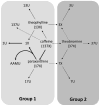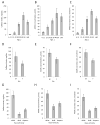Urine excretion of caffeine and select caffeine metabolites is common in the U.S. population and associated with caffeine intake
- PMID: 25833779
- PMCID: PMC5724768
- DOI: 10.3945/jn.114.205476
Urine excretion of caffeine and select caffeine metabolites is common in the U.S. population and associated with caffeine intake
Abstract
Background: Caffeine is a widely consumed psychoactive stimulant and is of epidemiologic interest. Major sources of caffeine are challenging to standardize, and the use of biomarkers is proposed as an alternative means of assessing intake.
Objective: We described urine caffeine and caffeine metabolite concentrations (n = 2466) and excretion rates (n = 2261) in the US population ≥6 y by age, sex, race-ethnicity, and caffeine intake (from foods, beverages, and dietary supplements).
Methods: We measured caffeine and 14 of its metabolites in spot urine samples from the cross-sectional NHANES 2009-2010 by use of LC-tandem mass spectrometry.
Results: Caffeine and its metabolites were detectable in the urine of most persons, generally at concentrations ≥1 μmol/L. Median concentrations (95% CI) ranged from 0.560 (0.497, 0.620) μmol/L to 58.6 (48.6, 67.2) μmol/L; median excretion rates from 0.423 (0.385, 0.468) nmol/min to 46.0 (40.7, 50.2) nmol/min. Urine concentrations and excretion rates for 9 analytes (caffeine, theophylline, paraxanthine, 1-methylxanthine, 1-methyluric acid, 1,3-dimethyluric acid, 1,7-dimethyluric acid, 1,3,7-trimethyluric acid, and 5-acetylamino-6-amino-3-methyluracil) had moderate correlations with caffeine intake (Spearman ρ = 0.55-0.68, P < 0.0001); the remaining analytes had low correlations (ρ = 0.15-0.33, P < 0.0001). We observed larger differences in geometric mean concentrations and excretion rates between the highest vs. lowest quartiles of caffeine intake for these 9 compounds than the rest. Consistent with dietary caffeine intake, we observed that urine concentrations and excretion rates for most compounds were significantly (P < 0.05) higher in men than women, non-Hispanic whites than Hispanics and non-Hispanic blacks, and highest in persons aged 40-59 y.
Conclusion: Excretion of caffeine and its metabolites in urine is common in the US population. According to the observed associations between spot urine concentrations or excretion rates with caffeine intake, several of these compounds show promise as potential biomarkers of caffeine intake.
Keywords: LC-MS/MS; NHANES; biomarkers; caffeine; dietary intake; metabolites; phenotyping; urine.
© 2015 American Society for Nutrition.
Figures


References
-
- US Department of Agriculture, Agricultural Research Service. What We Eat In America, Data Tables, 2009–2010 [Internet] Washington: US Department of Agriculture; 2012. [cited 2014 May 5]. Available from: http://www.ars.usda.gov/SP2UserFiles/Place/12355000/pdf/0910/tables_1-40....
MeSH terms
Substances
Grants and funding
LinkOut - more resources
Full Text Sources
Other Literature Sources
Medical

